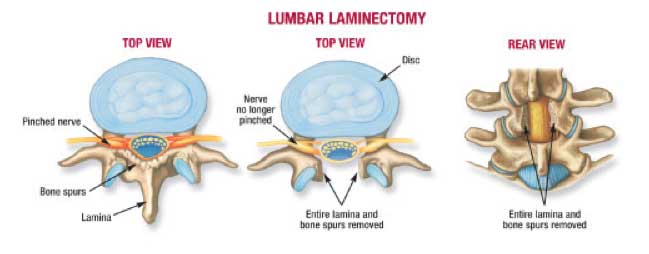Lumbar Laminectomy-Open
Lumbar Laminectomy-Open is a surgical procedure to remove a small portion of a vertebra, or back bone in the lower back (lumbar). Lumbar Laminectomy is usually done to take pressure off the spinal cord or a spinal nerve. It may also be done to access the spinal cord, bones and discs below the lamina, or the removed part of the bone. Spinal problems such as ruptured discs, bony spurs, or other problems can cause narrowing of the canals that the nerves and spinal cord run through. If it gets too narrow, it can irritate the nerve, causing:
- Pain in the leg
- Numbness or weakness
A Lumbar Laminectomy procedure is often performed along with a disc removal to help make the canal larger and take pressure off the irritated nerve.
Before the procedure
In the days before your surgery, tell your surgeon about any medications you take at home including herbal supplements and over-the-counter medications. You may be asked to stop taking aspirin or other medications that thin your blood and may increase bleeding.
- Tell your surgeon if you or someone in your family has any history of reaction to general anesthesia.
- If you smoke, you may be asked to stop smoking well before surgery and avoid smoking for a period of time after surgery.
- Before surgery you will probably be given instructions on when to stop eating and drinking. It’s common to have nothing to eat or drink after midnight on the night before the procedure.
- Ask your surgeon if you should take your regular medications with a small sip of water on the day of the procedure
During the procedure
- The surgeon will make an incision in the skinof your back over the affected area. The muscles and soft tissues around the spine will be pulled to the side, exposing the spine.
- The surgeon will then cut away bone, bone spurs, and ligaments that are compressing nerves. This is referred to as decompression. The surgeon may remove a small part or a large portion of several spinal bones, depending on your reason for the operation.
- Some people may also undergo spinal fusion to stabilize the spine, receive a special implant that will help stabilize the bones in the lower back but not restrict motion in the same way a fusion does, have a disc removed, or have additional removal of bone to widen the passageway where nerves leave the spinal canal.
At the end of the surgery, the wound will be stitched
After the procedure
Post Lumbar Laminectomy patient’s mobilization (return to normal activity) is largely dependent on his/her pre-operative condition and age.
- Patients are encouraged to walk directly following a Lumbar Laminectomy; however, it is recommended that patients avoid excessive bending, lifting, or twisting for six weeks after this surgery in order to avoid pulling on the suture line before it heals. You’ll need to limit your activities that include bending, stooping, or lifting for several weeks after your Lumbar Laminectomy.
- You’ll also need to keep the incision site clean and dry. Ask your doctor for instructions on showering and bathing.
- Your doctor will remove your stitches or staples after about two weeks
Risks of the procedure
Lumbar Laminectomy-Open is a relatively safe procedure. However; with all surgeries carry some risks. You will need to sign a consent form that explains the risks and benefits of the surgery. Some potential risks of cervical spine surgery include:
- Reactions to the anesthesia
- Bleeding
- Infection
- Nerve injury Spinal fluid leak
There may be other risks, depending on your specific medical condition. Be sure to discuss any concerns with your surgeon before the procedure.

